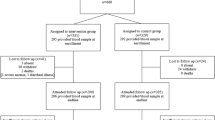Abstract
Objective: To assess changes in selenoprotein P levels in plasma from subjects who had received oral supplements of different selenium forms.
Design: The same study group participated in two similar selenium supplementation trials, Trial I in 1981 () and Trial II in 1987 (). During Trial II the mean baseline intake of selenium in Finland was higher compared to that during Trial I (100 and 40 μg/d, respectively), due to a nation-wide supplementation of fertilisers which started in 1985.
Subjects: Fifty healthy Finnish men, 36–60 y old.
Intervention: The study group received daily placebo or oral supplements consisting of 200 μg selenium as selenium-enriched yeast, sodium selenate or selenium-enriched wheat (Trial I) or selenium-enriched yeast, sodium selenate or sodium selenite (Trial II). The duration of supplementation periods was 11 (Trial I) and 16 (Trial II) weeks.
Results: In Trial I the mean plasma selenoprotein P values in all the supplemented groups increased significantly, approaching a plateau at 2 weeks and reaching maxima at 4 weeks (mean increase 34%, P<0.05). In Trial II the mean selenoprotein P levels of the supplemented groups were not significantly different from each other or from the placebo group at the start or at any time point of the supplementation period.
Conclusions: At a low selenium status the selenoprotein P levels increased in a similar fashion after supplementation with different forms of selenium, but at a high selenium status no significant effects of supplementation with the same amount of selenium were observed. No differences in selenoprotein P levels were observed for inorganic and organic selenium supplements.
Sponsorship: This study was supported by The Swedish Council for Forestry and Agricultural Research, the Påhlsson Foundation and the Swedish Nutrition Foundation.
This is a preview of subscription content, access via your institution
Access options
Subscribe to this journal
Receive 12 print issues and online access
$259.00 per year
only $21.58 per issue
Buy this article
- Purchase on Springer Link
- Instant access to full article PDF
Prices may be subject to local taxes which are calculated during checkout
Similar content being viewed by others
Author information
Authors and Affiliations
Rights and permissions
About this article
Cite this article
Persson-Moschos, M., Alfthan, G. & Åkesson, B. Plasma selenoprotein P levels of healthy males in different selenium status after oral supplementation with different forms of selenium. Eur J Clin Nutr 52, 363–367 (1998). https://doi.org/10.1038/sj.ejcn.1600565
Received:
Revised:
Accepted:
Published:
Issue Date:
DOI: https://doi.org/10.1038/sj.ejcn.1600565
Keywords
This article is cited by
-
Selenium speciation studies in cancer patients to evaluate the responses of biomarkers of selenium status to different selenium compounds
Analytical and Bioanalytical Chemistry (2024)
-
Systematic study of the selenium fractionation in human plasma from a cancer prevention trial using HPLC hyphenated to ICP-MS and ESI-MS/MS
Analytical and Bioanalytical Chemistry (2021)
-
Dietary pattern associated with selenoprotein P and MRI-derived body fat volumes, liver signal intensity, and metabolic disorders
European Journal of Nutrition (2019)
-
Selenium supplementation in radiotherapy patients: do we need to measure selenium levels in serum or blood regularly prior radiotherapy?
Radiation Oncology (2014)
-
The role of selenium, vitamin C, and zinc in benign thyroid diseases and of selenium in malignant thyroid diseases: Low selenium levels are found in subacute and silent thyroiditis and in papillary and follicular carcinoma
BMC Endocrine Disorders (2008)



